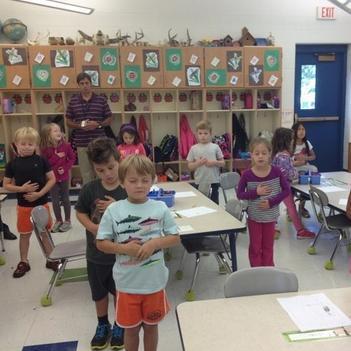Can Yoga and Mindfulness Help Children on the Autism Spectrum?
Touro Students Research Popular Program for Children With Autism

When a leading occupational therapist wanted evidence that her mindfulness and yoga practice was effective for children on the autism spectrum, she turned to Touro’s School of Health Sciences.
Occupational therapist Allison Morgan, is the founder of Zensational Kids and the author of Educate 2B, a school-based Yoga and Mindfulness Program. She trains educators and therapists in K-12 districts on how to implement breath, movement and mindfulness practices in the classroom as short breaks throughout the day.
“As a traditional therapist, we’re trained in using various techniques to teach children to calm down and relax,” Morgan explained. “Many of the traditional methods, require external input by someone else, or using props and environmental adaptations. Through the use of yoga and mindfulness tools, kids learn how to calm and regulate themselves using their own breath, body and mind to manage their nervous systems—they are able to do it anytime they need. And the more they use these strategies, the more effective they become.”
Looking for a way to provide objective evidence of the effectiveness of her program, Morgan reached out to Dr. Jill Horbacewicz, Chair of Touro’s School of Health Science Doctor of Physical Therapy (DPT) program. As part of their graduate requirements, each student of the SHS DPT program must complete a research project under the guidance of a faculty member.
“The Touro DPT program has all students participate in a faculty-driven research study,” explained Dr. Horbacewicz. “By performing research the students not only become critical consumers of the best evidence but become knowledgeable in all aspects of the research process as they generate evidence that is used to provide quality patient care.”
Working with Morgan, and under the guidance of SHS professor, Dr. Yocheved Bensinger-Brody, six students from the DPT program’s Manhattan Campus — Jacqueline Barresi; Rivka Bronchtain; Alana Genuth; Yael Gordon; Emily Rosen; and Hinda Shmidman — recruited 20 students from four special needs classrooms in a school in New Jersey. Students established a control group and an experimental group; the educators that were part of the experimental group received training in the Educate 2B Yoga and Mindfulness Program. In this one-day training, the educators learned how to teach the children in their classrooms, how to implement two-minutes of breath, movement and mindfulness three-times a day for eleven weeks. To gauge the effects, Touro students tested both groups with Devereux Student Strengths Assessment (DESSA) mini to assess social emotional competence and the Motor Assessment Battery for Children (MABC-2) to test their motor skills.
After the eleven-week period ended, children in the experimental group demonstrated improvements in social-emotional competence and behavior as measured by the DESSA-mini, and maintained their motor functioning as measured by the MABC-2. However, the children in control group showed no improvement in the DESSA mini and had a reduction in MABC-2 scores.
While the study is only a pilot study, the paper was already accepted for presentation at the Combined Sections Meeting of the American Physical Therapy Association that will be held in Texas in February. It has also been selected as a presentation at the 2017 Bridging Hearts and Minds of Youth Conference in San Diego in February.
DPT graduate ’16 Jacqueline Barresi, who participated in the research, said about the project, “I had the chance to actually experience how scientific research is conducted and how to implement evidence-based methods,” she said.
The research was especially important for DPT graduate ‘16 Rivka Bronchtain, who participated in the research.
“I want to work in a school setting and if this is something I can utilize I now know there is evidence behind it,” she said. “I’m not just using something sold to me as a product. I know there’s research that proves this is effective for kids.”

